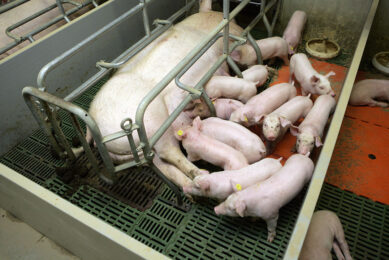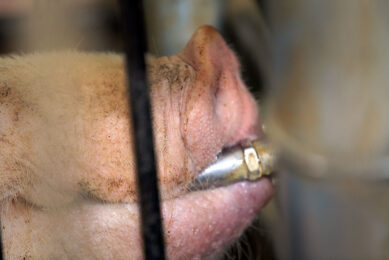Forced ventilation by fans (II)

A re-cap Quite true – the textbooks do tell you all about ventilation, but at considerable length and complexity. So much so, I believe, that many farmers end up by not reading it. I encounter this when asked to investigate problems caused by incorrect ventilation: They haven’t grasped one or other of the basic principles, hence the callout. What I am hoping to do in this mini-series is to outline the basics of fan ventilation simply and progressively. It is important that owners and managers understand them, as not doing so builds up a great deal of insidious (I use that word deliberately) cost, as I showed in the three tables in the previous issue. So let’s continue…
Rule 6
Unlike fans, which can be placed almost anywhere, as we saw in last month’s diagram of two completely opposite piggery ground-plans, inlet size and placing is extremely important. It is just as vital to control the inlets so that when they are fully open, a large volume of air can drop straight downwards to cool pigs when hot, as it is at the opposite extreme when the same inlet can be closed down to a narrow slit to project a much smaller quantity of cold air across the building on a long air travel to warm it up and slow it down before it reaches the pigs.
Rule 7
We all know the difference between winter and summer temperatures, but most climates in which we raise pigs consists, every week, of seven ‘winters’ during the nights and seven ‘summers’ during daytime. At night when the outside air is colder, a smaller volume of air is needed, thus the fan speed is reduced – or better some fans are cut out – and the inlets are narrowed to maintain the same air pattern. In daytime more air is drawn in to maintain the correct temperature and so the inlets are widened to keep the same air pattern flowing and if needed, more fans are reactivated. All this is quite complicated but easy enough for a microchipped device (the controller) linked to strategically-placed temperature sensors over the pigs. ‘Dicam’ from Farmex is a well-proved device and there are others.
Rule 8
Two camps of opinion here. I favour exhausting the air, as such systems have given much less trouble when things get out of kilter. A fan exhausting air from a properly sealed building has to draw in air from the inlets so the building is ‘pressurised’ anyway. There is however one important exception to this rule when using, in certain buildings, the excellent and undervalued ‘airbag’ partial recirculation system (because it is cheap and effective). This blows in air distributed through a plastic duct which must be kept inflated, thus a pressure system is needed.
Rule 9
This is usually sufficient to ventilate most spaces in which we house pigs. This amount of inlet speed is needed to drive the correct air patterns, whether the volume is large or small.
Rule 10
This is the area where farmers – and I have found, some of their advisers – get wrong. Wrong because the basic information needed below is insufficient or miscalculated.
Maximum ventilation rate is calculated by assessing maximum stocking density based on liveweight, under the hottest summer conditions in relation to the UCT (Upper Critical Temperature) limit of the pigs. Both UCT and LCT (see below) will be explained next month. Maximum ventilation rate can be ameliorated by spraying with water droplets in the most extreme heat conditions and this needs careful timing control so as not to chill the pigs – especially weaners, when the temperature falls at dusk – which is often underestimated even in a ‘heatwave’.
Minimum ventilation rate is calculated from tables which will still comply with the 13 ‘essentials’ listed in Figure 1 in the previous issue, and yet keep the pigs, when it is very cold outside, just above their LCT (Lower Critical Temperature). LCT is the temperature surrounding them below which the body starts to divert food energy away from growth or reproduction into just trying to keep warm. LCT can be eased by supplementary heating, especially for smaller pigs, which of course raises cost and has to be set against improving insulation, etc.
The supplementaries
There are other items which should be borne in mind when assessing ventilation needs.
Fail-safe devices (automatic drop-out panels and an alarm system) must be built-in.
Beware of obstructions: Ribs, purlins, fluorescent tubes close to the ceiling, pipes and pen divisions can disturb air distribution. Simple smoke tubes will reveal such obstructions.
Lids and covers often create an over-stuffy ventilation microclimate all of their own which some commonsense adjustment will rectify.
[Source: Pig Progress magazine Vol 29 nr 6, 2013 – ‘What the textbooks don’t tell you about…’ series ]











